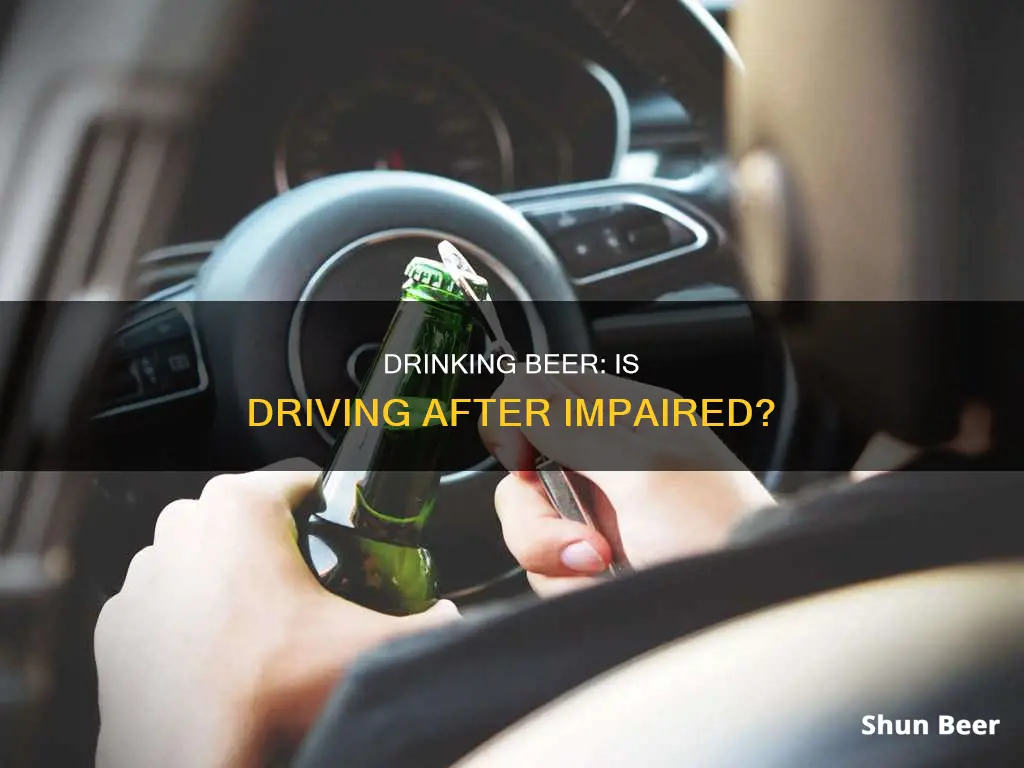
Alcohol consumption and driving is a dangerous combination. While the legal alcohol limit for driving in the UK is 80 milligrams of alcohol per 100 millilitres of blood or 35 micrograms of alcohol per 100 millilitres of breath, it is important to understand that alcohol affects individuals differently. Factors such as weight, age, gender, metabolism, and the type of alcohol consumed influence how alcohol is processed by the body. As a result, even a single pint of beer can impair an individual's driving ability, slowing their reaction time, impairing their judgement, and reducing their coordination.
| Characteristics | Values |
|---|---|
| Amount of alcohol in a pint of beer | 2.3 units of alcohol |
| Legal alcohol limit for driving in the UK | 80 milligrams of alcohol per 100 millilitres of blood or 35 micrograms of alcohol per 100 millilitres of breath |
| Time for alcohol to leave the body | 2-3 hours |
| Factors affecting alcohol tolerance | Age, weight, gender, genetics, medications, and health conditions |
| Factors affecting metabolism rate | Age, biological sex, body weight, food consumption, and other substances or medications |
What You'll Learn

Factors affecting alcohol tolerance
Alcohol tolerance varies from person to person and is influenced by a multitude of factors. Here are some key factors that affect alcohol tolerance:
Age, Weight, and Body Composition
Age, weight, and body composition are significant factors in alcohol tolerance. Younger individuals and those with lower body weight tend to have lower alcohol tolerance. This is because alcohol can be distributed throughout the body via the circulatory system, entering most tissues except bone and fat (adipose tissue). As the percentage of body fat increases, the resulting concentration of alcohol in the lean tissues is proportionally higher.
Gender
Gender plays a role in alcohol tolerance, with women generally having lower tolerance than men due to differences in body composition and metabolism. Women tend to be smaller than men and have lower levels of alcohol dehydrogenase, the enzyme that metabolizes alcohol. As a result, alcohol remains in a woman's bloodstream longer, leading to faster intoxication.
Genetics and Ethnicity
Genetics and ethnicity also influence alcohol tolerance. Children of parents with a history of alcoholism have a higher risk of developing alcoholism themselves. Additionally, certain ethnicities, such as individuals of Asian or Native American descent, may have reduced levels of alcohol dehydrogenase, causing alcohol to remain in the blood longer and leading to faster intoxication.
Health Conditions and Medications
Health conditions and medications can also impact alcohol tolerance. Mixing alcohol with certain medications, such as aspirin, ibuprofen, or acetaminophen, can create a "bottleneck" in the liver, slowing down the metabolism of alcohol and leading to increased intoxication.
Food Consumption
The consumption of food can also affect alcohol tolerance. Food in the stomach slows the absorption of alcohol into the bloodstream, delaying impairment. Larger meals, consumed closer to the time of drinking, can lower the peak blood alcohol concentration.
Carbonated Beverages
Carbonated beverages, such as mixing alcohol with Coca-Cola or tonic water, will be absorbed more quickly into the bloodstream, leading to faster intoxication.
It is important to note that while these factors influence alcohol tolerance, the legal alcohol limit for driving remains the same. Driving under the influence of alcohol is illegal and dangerous, and it is always safer to avoid driving after consuming any amount of alcohol.
Flight vs Growler Beer: What's the Difference?
You may want to see also

Alcohol metabolism rates
One crucial factor affecting alcohol metabolism is the presence of food in the stomach. Food slows down the absorption of alcohol by physically obstructing its contact with the stomach lining and preventing it from passing into the small intestine. Greasy, high-protein, and fatty foods are particularly effective in delaying the absorption of alcohol, as they take longer to digest.
Individual characteristics, such as body composition, also play a role in alcohol metabolism rates. Women generally have higher peak blood alcohol levels than men when consuming the same amount of alcohol per unit of body weight. This is due to women typically having a higher percentage of body fat, which affects the distribution and elimination of alcohol in the body. Additionally, men tend to have higher levels of enzymes that break down alcohol in the stomach before it enters the bloodstream.
The rate at which alcohol is consumed also impacts metabolism rates. Drinking alcohol rapidly or gulping drinks leads to faster intoxication compared to sipping or drinking slowly, as it results in a larger amount of alcohol entering the bloodstream over a short period.
Furthermore, the type of alcoholic beverage consumed influences metabolism rates. Craft beers with a high alcohol by volume (ABV) can have significantly higher alcohol content, and their impact on blood alcohol content cannot be easily predicted. Carbonated alcoholic drinks and those mixed with sugars and juices also increase the rate of alcohol absorption.
It is important to note that certain medications, liver damage, and health conditions can affect the effective metabolism of alcohol. Additionally, mixing alcohol with medications or drugs can lead to serious complications and should be avoided.
To summarize, alcohol metabolism rates are influenced by individual factors such as gender and body composition, the presence of food in the stomach, the amount and speed of alcohol consumption, and the type of alcoholic beverage. Understanding these factors is crucial to make informed decisions about alcohol consumption and to avoid driving under the influence.
Beer vs. Malt Liquor: Understanding the Core Distinction
You may want to see also

Blood alcohol concentration (BAC)
BAC is influenced by various factors, including age, weight, gender, metabolism, and the amount of alcohol consumed. These factors determine how quickly alcohol is absorbed and metabolized by the body. For example, females tend to metabolize alcohol differently and experience its effects more than males, even if they are the same size. This is due to lower body water volume, hormonal factors, and lower levels of liver enzymes that break down alcohol.
The "one drink an hour" rule, which suggests that consuming 1.25 ounces of hard liquor, one beer, or one glass of wine per hour will keep BAC below the legal limit, is a common misconception. The truth is that every individual is unique in terms of body chemistry, metabolism, and other factors that influence BAC. Additionally, different alcoholic drinks have varying alcohol content, so simply counting drinks may not provide an accurate assessment of BAC.
To ensure safety, it is generally recommended to avoid driving after consuming any amount of alcohol. The effects of alcohol on driving abilities, such as impaired judgment, slowed reaction time, reduced coordination, and impaired ability to track moving objects, pose significant risks. Recognizing the signs of alcohol impairment and planning alternative transportation arrangements are crucial for responsible drinking and driving behaviour.
St. Bernardus Beers: Understanding Their Unique Differences
You may want to see also

The one drink an hour rule
The "one drink an hour" rule is a common guideline that many people follow to avoid exceeding the blood alcohol content (BAC) limit of 0.08%. This rule states that if an individual consumes no more than one drink (approximately 1¼ ounces of hard liquor, one beer, or one glass of wine) per hour, they should be safe to drive. However, it's important to recognise that this rule is not foolproof and may not be effective for everyone.
The effectiveness of the "one drink an hour" rule varies from person to person due to differences in body composition and chemistry. Factors such as weight, height, body fat, metabolism, age, gender, and liver volume influence how quickly alcohol is absorbed and metabolised by the body. For example, a man who weighs 200 pounds may be able to have two drinks and remain under the legal limit, while a woman weighing 140 pounds could be over the limit after the same number of drinks.
Additionally, not all alcoholic drinks are created equal. Different types of drinks, such as beer, wine, or hard liquor, can have varying alcohol content and affect individuals differently. The strength or ABV (alcohol by volume) of the drink also plays a significant role. For instance, craft beers often contain a higher ABV than traditional beers, and a 16-ounce pint typically contains more alcohol than a standard 12-ounce serving.
It's crucial to understand that the "one drink an hour" rule is just a guideline and not a guarantee of sobriety or legal compliance. Alcohol can impair judgment, coordination, and decision-making skills, and these impairments can vary based on individual factors. As such, it is recommended to avoid driving after consuming any amount of alcohol. If you plan to drink, it is best to arrange alternative transportation or designate a sober driver.
While the "one drink an hour" rule may provide a general framework for responsible drinking, it is important to remember that the effects of alcohol can vary significantly from person to person. Understanding your personal alcohol limits, recognising the signs of impairment, and prioritising safety are crucial when it comes to drinking and driving.
Exploring Beer and Liquor: What Sets Them Apart?
You may want to see also

Effects of alcohol on driving ability
Alcohol can significantly impair your ability to drive safely. Even one pint of beer can affect your driving, depending on various factors such as weight, gender, metabolism, and the strength of the beer. It is crucial to understand these factors and their impact on alcohol tolerance to ensure safe driving.
Alcohol slows down reaction time, impairs judgment and coordination, and makes it challenging to focus on the road and control the vehicle's speed. These effects can increase the risk of accidents and cause serious legal consequences, including fines, license suspension, or even imprisonment.
The legal alcohol limit for driving in the UK is 80 milligrams of alcohol per 100 millilitres of blood or 35 micrograms of alcohol per 100 millilitres of breath. In the United States, a Blood Alcohol Concentration (BAC) of 0.08 grams of alcohol per deciliter or higher is considered above the legal limit. However, it is important to note that your driving skills can be impaired even if you are below this limit.
The rate at which alcohol is metabolized varies from person to person. On average, the liver can process around one ounce of liquor per hour, which is roughly one standard drink. However, this rate can be influenced by factors such as age, biological sex, body weight, food consumption, and other substances or medications.
To ensure safe driving, it is recommended to avoid drinking any amount of alcohol before getting behind the wheel. If you plan to consume alcohol, it is essential to make alternative transportation arrangements, such as a designated driver, taxi, or public transportation. By following these precautions, you can help keep yourself and others safe on the road.
Cerveza vs Beer: What's the Difference?
You may want to see also
Frequently asked questions
A pint of beer contains approximately 2.3 units of alcohol.
Alcohol impairs judgement, slows reaction time, inhibits coordination, and affects your ability to focus, control speed, and track moving objects.
It takes approximately 2 hours for a pint of beer to leave your system. However, this varies depending on factors such as age, weight, gender, and metabolism.







